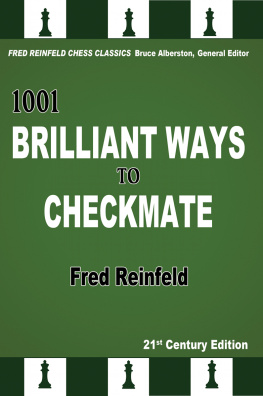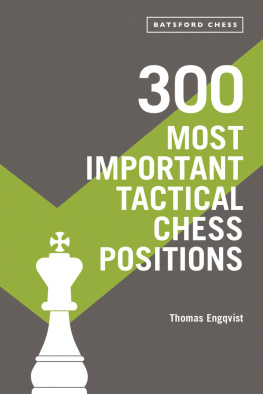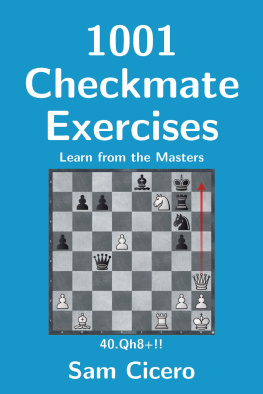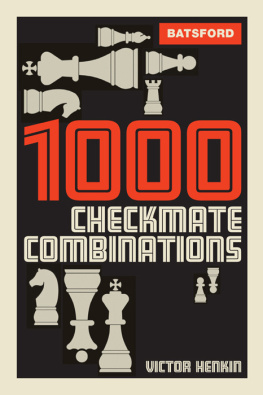
1001
Brilliant Ways to Checkmate
by
Fred Reinfeld
21st-Century Edition
Fred Reinfeld Chess Classics
Bruce Alberston, General Editor

2014
Russell Enterprises, Inc.
Milford, CT USA 1001 Brilliant Ways to Checkmate by Fred Reinfeld 21st-Century Edition
Fred Reinfeld Chess ClassicsBruce Alberston, General Editor ISBN: 978-1-936490-82-0 (Print) Copyright 2014 Don Reinfeld, Judith Reinfeld and Bruce Alberston All Rights Reserved No part of this book may be used, reproduced, stored in a retrieval system or transmitted in any manner or form whatsoever or by any means, electronic, electrostatic, magnetic tape, photocopying, recording or otherwise, without the express written permission from the publisher except in the case of brief quotations embodied in critical articles or reviews. Published by: Russell Enterprises, Inc. P.O. Box 3131 Milford, CT 06460 USA http://www.russell-enterprises.com Cover design by Janel Lowrance

Preface
Many of todays players, now the grandparents of chessplaying teenagers, fondly recall growing up with the Reinfeld books, which covered all aspects of chess, from the openings to the endgame, and included generous helpings of chess lore and the lives of the greatest chess masters. Reprinting chess books by our father, Fred Reinfeld (1910-1964), ended in the 1980s as descriptive notation was phased out in favor of the more popular algebraic notation. We are extremely grateful to Bruce Alberston, who has taken up the task of converting Reinfelds notations to algebraic.
Thanks also to Russell Enterprises for publishing a 21st-century version of this, and, hopefully more, Reinfeld chess classics, thereby introducing Fred Reinfelds teaching genius to new generations of chess enthusiasts, especially to beginners and mid-level players eager to sharpen their skills at the chessboard. Don and Judith Reinfeld
Editors Introduction
This is the all-time great checkmate collection. Anything that has come out post-1955 automatically gets compared with Reinfelds masterful compilation, and usually unfavorably. These are all forced checkmate positions, culled mainly from actual play, thus the positions look game-like. Plus, Reinfelds selection is simply marvelous; he seems to have captured every conceivable theme. In fact, hes organized the chapters by theme, such as Queen Sacrifices, Double Check, Pawn Promotion, but after that no more hints.
Theres no one tapping you on the shoulder telling you this one is easy, the next one is hard. You have to figure that out for yourself. The sheer number of examples, 1001, is both catchy and daunting, and you may well ask, Does anyone go through all the positions? The answer is yes, your editor for one. Back in the fall of 1978, my chess was slipping, so I took drastic measures. I quit my job (naturally Im not recommending this to everyone) and went over to a chess training program which included physical exercise, opening study, tactical exercises and tournament play. The tactical exercise book was the one you have in your hand, 1001 Ways to Checkmate (Brilliant was added in later editions).
Approaching the matter seriously, I set a chess timer for a group of ten, recorded my answers on a sheet of paper, and then checked the solutions in the back of the book. Overly scrupulous, recording all variations I could think of, I even considered a problem wrong if I made a notational mistake. Results were not instantaneous but the training program eventually paid off. I became a much sharper tactician and in about nine months I was playing at master level. For whatever reason, the U.S. Chess Federation was way behind on their rating results, so the actual master rating took another year to reflect itself.
So we have personal testimony: the Reinfeld Checkmate book works. And so does the companion volume 1001 Chess Sacrifices and Combinations. For the present edition, all the diagrams have been set again using Linares fonts. These are clear and easy to read. Since I threw out my thirty-year old notebooks a few years back, I had to solve each position anew. This is just as well, since I had to convert to modern algebraic notation anyway. Just so the reader understands, the solutions reflect my solving the positions in the spring of 2012 and then reconciling with Reinfelds 1955 originals.
There are a few corrections along the way and an additional side line here and there. But for the most part I was guided by Reinfelds formula, which was to let the main lines speak for themselves. Its not that he didnt show sidelines, it just that he didnt believe in getting tangled up in them. As for the corrections mentioned, you can certainly find more by turning your computer loose on the positions. Of course this defeats the purpose of working things out for yourself, but its always fun to catch the masters in a mistake. Hey, I was an amateur once; I still remember the feeling.
In any case, Ill defer to Reinfeld for any mistakes the reader may find. Blaming your predecessor is tried a true method of getting off the hook. Of course the way to tackle this book is to pick a chapter and solve the problems, one at a time. And dont think of it as drudgery. Youll have a lot more fun if you approach the positions as mini-challenges. Also dont feel like you have to solve every single problem the first time around.
You can do what I did, put the missed problems on a wrong list, come back, and do them later. Theres a group of Two-Move Composed Problems beginning with #931 and running to the end of the book. I have to admit I did not work through these back in 1978-1979. I waited some twenty years before I eventually went through them all. You might want to do something similar, but you dont have to wait twenty years. Summing up, this is an outstanding book to hone your tactical abilities: recognizing mating patterns, developing visualization skills, enhancing imagination, and improving tactical sharpness.
You can probably think of other good things as well. Bruce Alberston Astoria NY January 2014
Chess Notation
The chessboard can be viewed as an 8x8, 64 square grid, where each individual square is given a name. Heres how its done: First, the vertical rows (files) are given lower case letter names, a through h. Second, the horizontal rows (ranks) are named by the numbers one through eight, running up the board. The intersection of file letters with rank numbers provide the names of the squares. Sample square names

Three of the pieces in the diagram stand on their initial starting squares: the white king on e1, the black queen on d8, and the white rook on a1.
The white bishop is on g2, the black pawn on g6 and black knight on d4. X marks the spot, the intersection of the c-file with the fourth rank, the vacant square c4. Pieces have capital letter abbreviations: K for king, Q for queen, R for rook, B for bishop and N for knight. Pawn moves are shown by the squares they move to and capital P is rarely used. Heres a short sample game given in long form algebraic notation.
| White | Black |
| e2-e4 | e7-e5 |
| Bf1-c4 | Bf8-c5 |
| Qd1-h5 |
Next page












 2014
2014 Three of the pieces in the diagram stand on their initial starting squares: the white king on e1, the black queen on d8, and the white rook on a1.
Three of the pieces in the diagram stand on their initial starting squares: the white king on e1, the black queen on d8, and the white rook on a1.